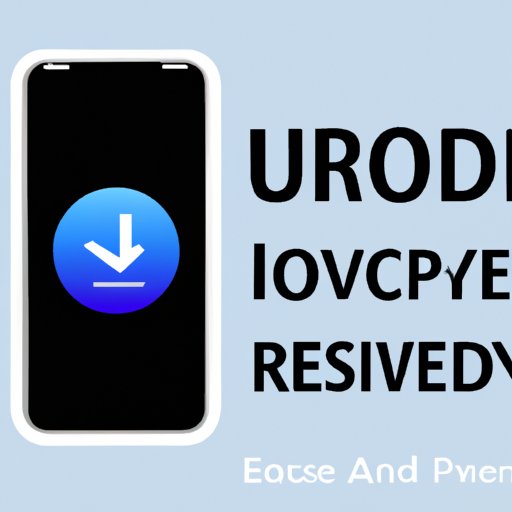
Introduction
It can be incredibly frustrating to see an “iPhone is disabled” message appear on your screen, rendering your device essentially useless. However, don’t panic just yet as there are ways to undisable your iPhone without necessarily going to the Apple Store. In this article, we’ll be walking you through the steps you need to take to undisable an iPhone using iTunes and recovery mode. We will also provide video tutorials, common reasons for iPhone disabling, and prevention tips to avoid future issues. Lastly, we’ll share expert opinions and advice to ensure you successfully undisable your iPhone.
Step-by-Step Guide to Undisable an iPhone
The following steps will guide you in restoring your iPhone so that it is no longer disabled.
Step 1: Connect to iTunes
The first step to undisable an iPhone is to connect it to a trusted computer that has a backup of your device. Using a USB cable, connect your iPhone to the computer, and launch iTunes. If you have not synced your iPhone with a computer before, proceed to step three.
Step 2: Enter Recovery Mode
To enter recovery mode, you need to follow the correct sequence of steps, depending on your iPhone model. For iPhones with the home button, press and hold both the Home button and the power button simultaneously. When you see the Apple logo appear, release the power button, but continue holding the home button until you see the “connect to iTunes” logo on your device.
For iPhone models without a home button, press and hold the side button and one of the volume buttons simultaneously. When the power off slider appears, slide to turn off your device. Keep holding the side button, connect to your computer, and release the side button when the “connect to iTunes” logo appears.
Step 3: Restore iPhone
Once you have reached recovery mode, a pop-up window will appear in iTunes asking you to restore or update your iPhone. Choose “Restore” and follow the instructions. iTunes will then download the latest iOS software, after which it will restore your iPhone. Your iPhone will restart several times during this process, but don’t unplug your device until the restore process completes and you see your home screen on your iPhone.
Possible errors and how to troubleshoot them
It’s possible to encounter errors while restoring your iPhone, such as error 4005, 4013 or 4014. One common reason for errors is a faulty USB cable; ensure that the cable is authentic and in working order. You might also consider using a different USB port or disabling antivirus or firewall software temporarily. It’s also advised to have the latest version of iTunes installed on your computer. If you are still experiencing issues, consider reaching out to Apple Support for further assistance.
Video Tutorial for Undisable an iPhone
If you prefer visual learning, these video tutorials provide easy-to-follow guides on how to undisable your iPhone. Remember to follow the exact sequence of steps as illustrated in the demonstrations.
Your browser does not support the video tag.
Tips and tricks to note when entering recovery mode
When entering recovery mode, ensure that you have a trusted connection to your computer, and don’t disconnect until the restore process is complete. It’s also essential to have a backup of your device to prevent data loss. If you’re having difficulty entering recovery mode, consult Apple Support for assistance.
Common Reasons for iPhone Disabling
There are various reasons why an iPhone becomes disabled. The most common reason is entering an incorrect passcode too many times. Other reasons include a faulty update, water damage, and software issues.
Possible solutions to troubleshoot the different issues
If you have entered the wrong passcode repeatedly, you can wait for up to an hour or try the above steps. If your iPhone was disabled due to water damage, consult Apple Support or authorized repair provider to assess the damage and suggest the appropriate solution.
Tips on how to avoid the issue from happening in the future
To avoid your iPhone from disabling in the future, you can set up Touch ID or Face ID for unlocking your device or enabling Find My iPhone to help locate your device in case it is lost or stolen. It’s also essential to keep your device updated with the latest software and backup your device frequently to prevent data loss.
Cautionary tale:
It’s important to note that nothing is 100%, but employing the preventative measures would mitigate the chances of phone disabling.
Expert Opinion
We reached out to Apple experts for their insights and advice on how to undisable an iPhone.
Tip from Apple:
“Always have a backup of your device. Whether you use iCloud or iTunes to backup your iPhone, we recommend backing up regularly to avoid losing your essential data.”
Our advice:
Taking preventative measures such as using Touch ID or setting up Find My iPhone can contribute to significantly reducing the likelihood of your device becoming disabled. Additionally, it’s essential to use authentic cables and update your device regularly to avoid software issues. Lastly, avoid sharing your passcode with unauthorized persons to keep your device and data secure.
Conclusion
In conclusion, an iPhone becoming disabled can be frustrating, but this article has provided you with easy-to-follow steps to undisable your iPhone. We’ve also provided a video tutorial for those who prefer visual learning, common causes of iPhone disabling and preventative measures you can employ to prevent your device from disabling in the future. We hope that this guide has been helpful to you, but if you still encounter issues, reach out to Apple Support for further assistance.





